Who can resist giving their Labrador a tasty treat from their dinner plate? But is “human food” safe for your dog, or could it be harmful? Whether you are a new or an experienced Labrador owner, it’s essential to know what foods they can and can’t eat. So, what foods are poisonous to Labradors?
Foods poisonous to Labradors are chocolate, macadamia nuts, walnuts, onions, garlic, leeks, grapes, raisins, alcohol, caffeine, salt, and products sweetened with xylitol. Some less well-known foods toxic to Labs are raw potatoes, yeast dough, green tomatoes, and moldy food.
In this article, I’ll share the main foods poisonous to Labrador Retrievers, including the grave risks they can cause your dog. But some toxic foods are not so obvious, which I refer to as hidden dangers!
I’ll also cover what to do if your Labrador accidentally eats something toxic. This is important as the sooner your Lab is treated, the better chance of recovery. We’ll also take a quick look at some of the human foods your dog can eat, especially as we all enjoy giving our pets a little treat now and again.
Finally, I have a bonus feature for you – a short interview with a licensed veterinarian on food toxins.
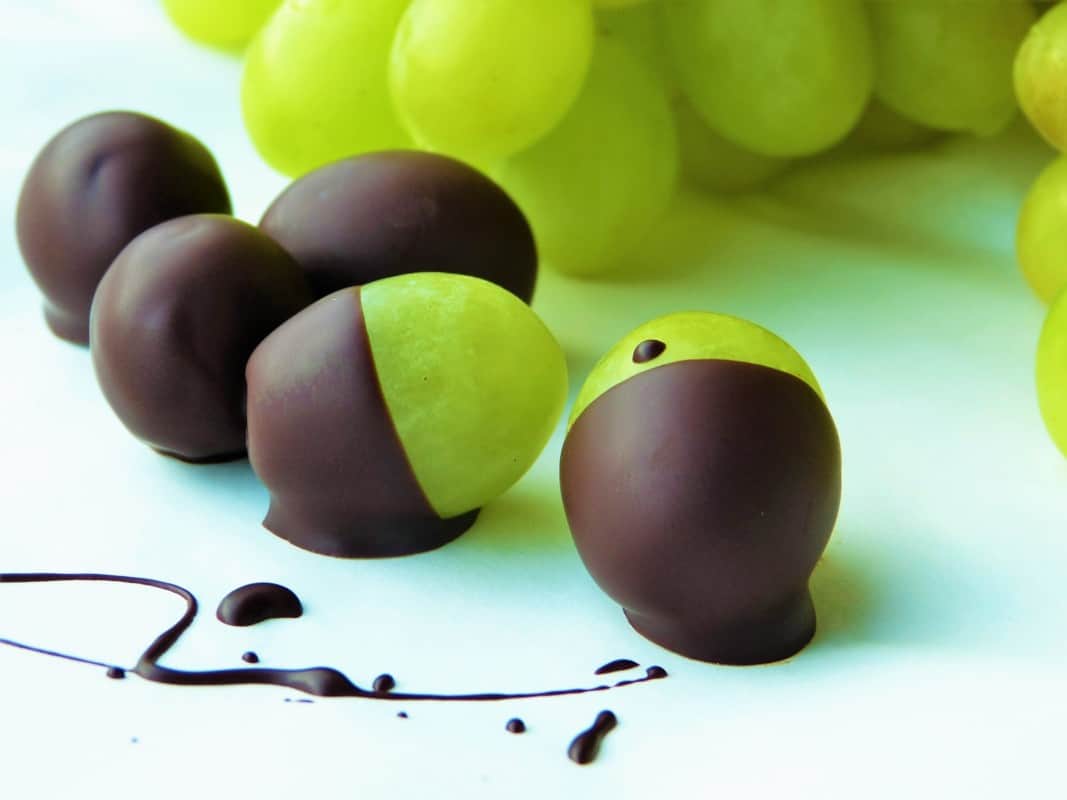
So, let’s dive into all the poisonous foods that your Labrador can’t eat.
What Foods Are Poisonous to Labradors?
Research over the past decade shows that most dog owners unintentionally feed poisonous foods to their pets due to a lack of knowledge, as highlighted in this report on household food items toxic to dogs and cats. Therefore, if this article helps save just one Lab, I will be more than happy.
Discover What Foods Your Labrador Can’t Eat In This Video…
Alcohol
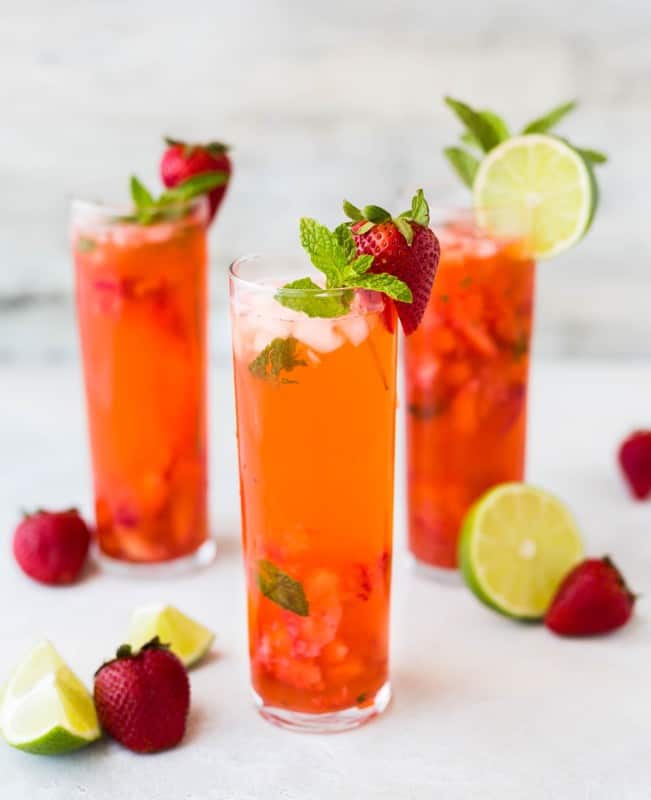
Labradors should not drink alcohol as it is toxic to dogs. Mild alcohol poisoning can cause a dangerous drop in blood sugar, vomiting, diarrhea, muscle incoordination, and poor breathing. Severe cases involve seizures, respiratory failure, and death can occur 12 to 24 hours after ingesting.
Alcohol has a similar effect on dogs that it has on humans in that it affects the liver and brain. However, the slightest amount of alcohol can be deadly for your Lab.
Although I can’t imagine someone giving their dog a swig of beer or a gin and tonic, some dogs will try to drink alcoholic drinks straight out of an unattended glass or may lap them off the floor if they are accidentally spilled.
Also, don’t forget the “hidden places” where alcohol lurks, e.g., unbaked yeast bread dough and desserts.
In addition, alcohol exists where you wouldn’t realize it, such as mouthwash, perfume, and cleaning products. Oh, and don’t forget about hand sanitizer! Remember to these out of reach.
If you grow fruit at home, such as apples, be careful once the fruit has fallen from the tree and starts to decompose as it produces ethanol (alcohol). There was a sad case of ethanol intoxication from the ingestion of massive rotten apples by a dog who died 48 hours later. Never leave your Labrador Retriever unsupervised where they can have free access to fruit.
Avocado
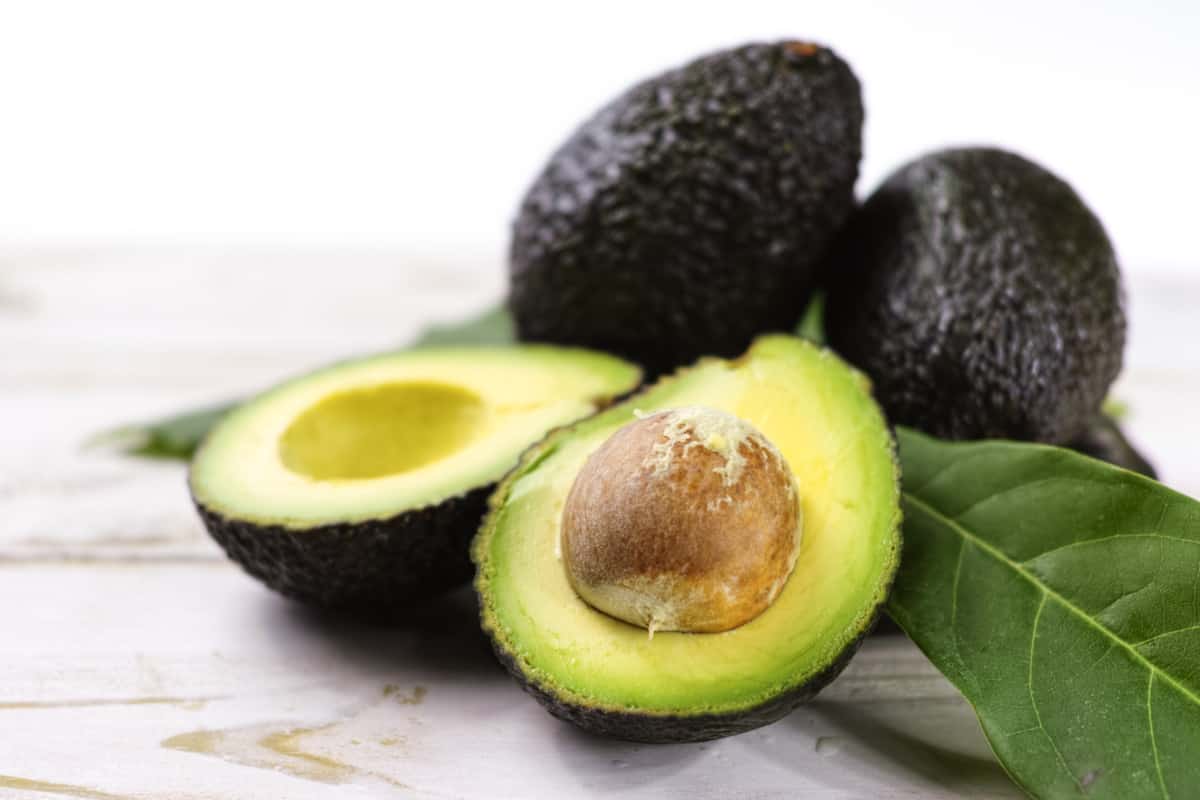
Labradors can not eat avocado as it is toxic to dogs. The skin, leaves, pit, and bark of avocados are all poisonous as they contain persin, which can cause vomiting, diarrhea, abdominal discomfort, and difficulty breathing. Severe cases of poisoning can cause oxygen deprivation and can lead to death.
Avocados can affect your dog’s lungs and chest due to a build-up of fluid. The fleshy part of the fruit doesn’t have as much persin as the rest of the plant, but it is still poisonous for your dog to eat.
The high-fat content of this fruit can also lead to pancreatitis, and the avocado pit is a choking hazard. If you grow avocados at home, remember to keep your dog away from the plants.
Black Walnuts
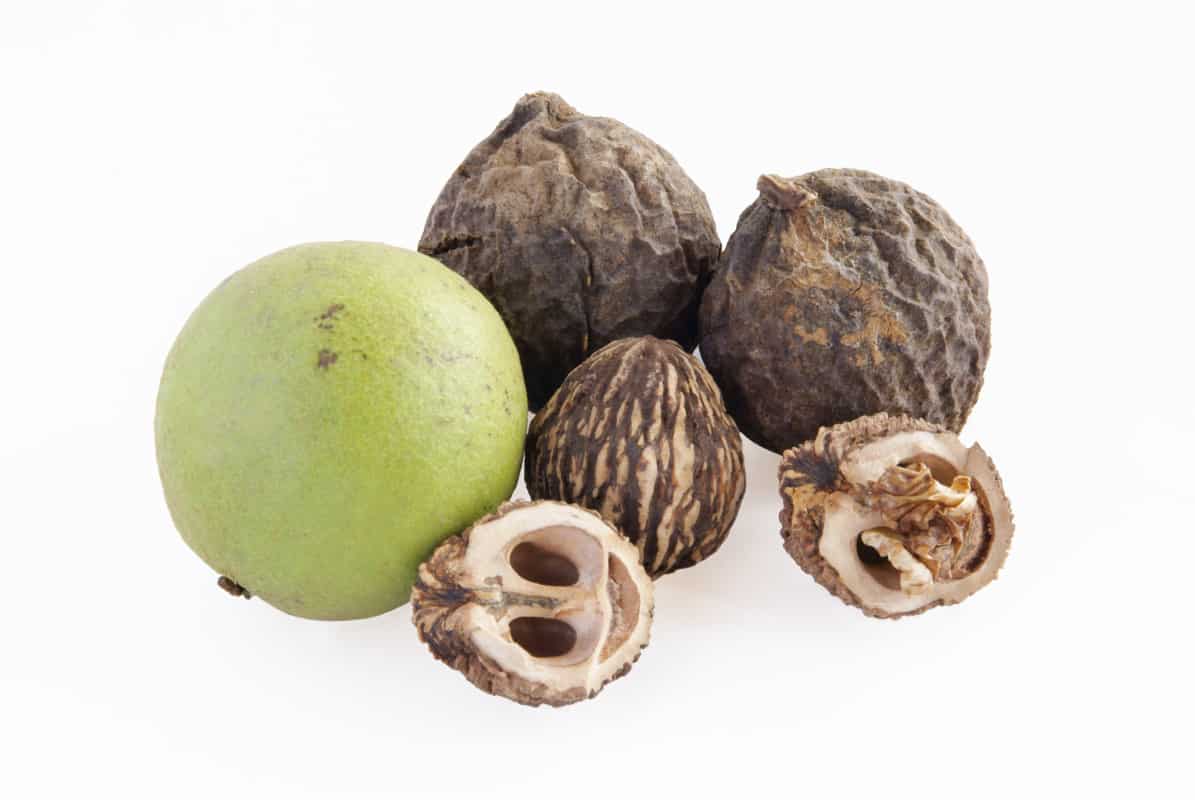
Labradors should not eat black walnuts as they are toxic to dogs due to an unknown toxin. Symptoms include vomiting, restlessness, panting, fever, and lack of coordination. Severe cases of walnut poisoning can result in seizures, tremors, liver failure, and the death of your Lab.
Another danger is if old walnuts have been lying on the ground and turned moldy, the mold becomes an additional poison, and you have double trouble ahead.
Although some nuts are okay for Labradors to eat, such as cashews or almonds, you must give them in moderation due to their high fat content. Nuts can easily cause a stomach upset in dogs, and feeding your Lab foods high in fat content can also lead to pancreatitis or obesity.
I prefer to leave all nuts on my “unsafe list of foods for Labs” as they’re also a choking hazard.
Blue Cheese
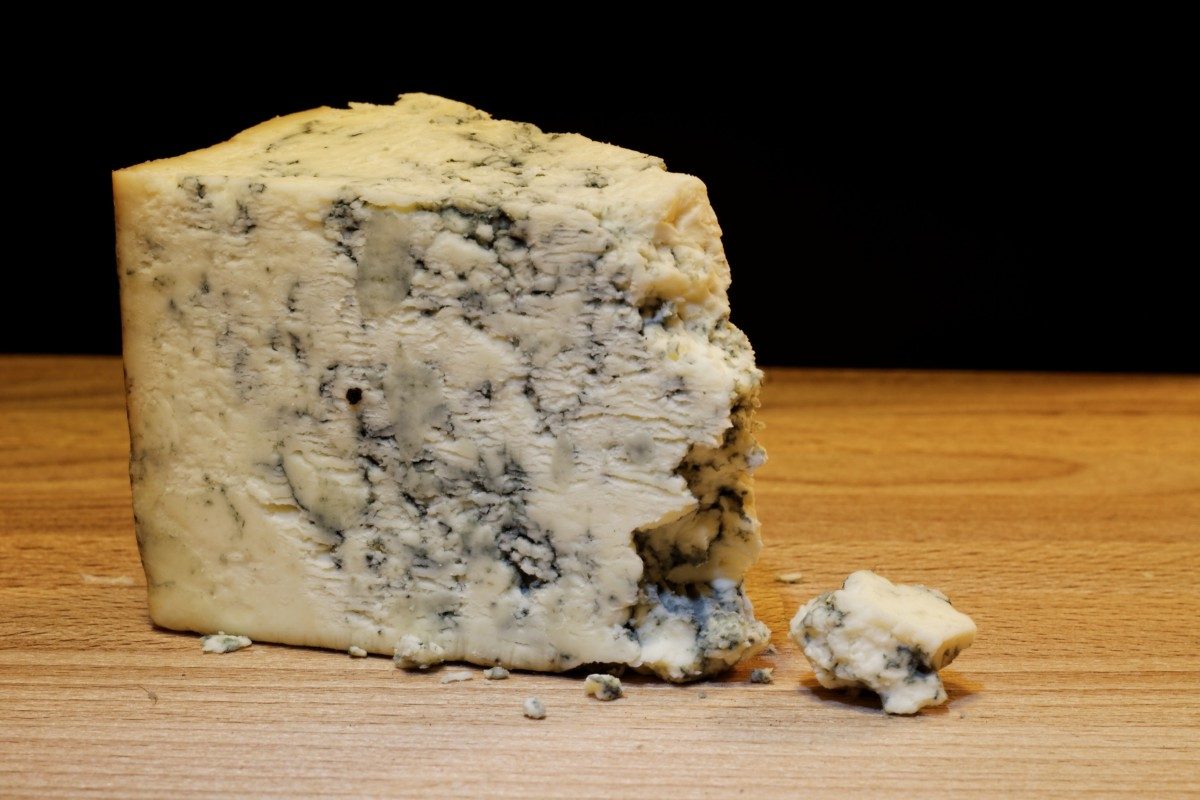
Labradors cannot eat blue cheese, such as blue stilton. The fungus used to make blue cheese contains a substance called roquefortine C, which is toxic if ingested by your dog. If blue cheese is eaten in large doses, it can cause vomiting, diarrhea, high temperature, tremors, twitching, and seizures.
However, other cheese, such as mild cheddar, is safe for dogs to eat, but some Labs may find it difficult to break down like other dairy products. This is known as lactose intolerance.
All dairy products contain different amounts of lactose. Whether your Lab can enjoy small pieces of safe cheese comes down to the individual dog. Remember, too, that foods high in fat can cause a stomach upset.
For example, my dog enjoys small pieces of cheddar as a treat, an occasional lick of milk, and plain or Greek yogurt added to her food as a topping. However, she cannot tolerate even an iota of heavy cream, which makes her sick.
Be wary if your dog is the scavenger type and tries to get in the trash if there’s any old festering blue cheese.
Caffeine (Tea, Coffee, etc.)

Labradors cannot drink tea or coffee as they contain caffeine which is toxic to dogs. Ingestion of caffeine can be fatal in severe cases as it overstimulates the nervous system, causing a fast heartbeat and leading to death. Less severe symptoms include excessive thirst, vomiting, and tremors.
Your Lab will be fine if he just has a lick or two of your drink. However, several deaths of dogs have occurred due to caffeine overdose.
Keep your Lab away from coffee, tea, cocoa, chocolate, colas, and energy drinks. Caffeine is also present in some supplements, cold medicines, and painkillers. This report details the sad case of a Yorkshire Terrier who died from ingesting an over-the-counter caffeine supplement.
Cherries
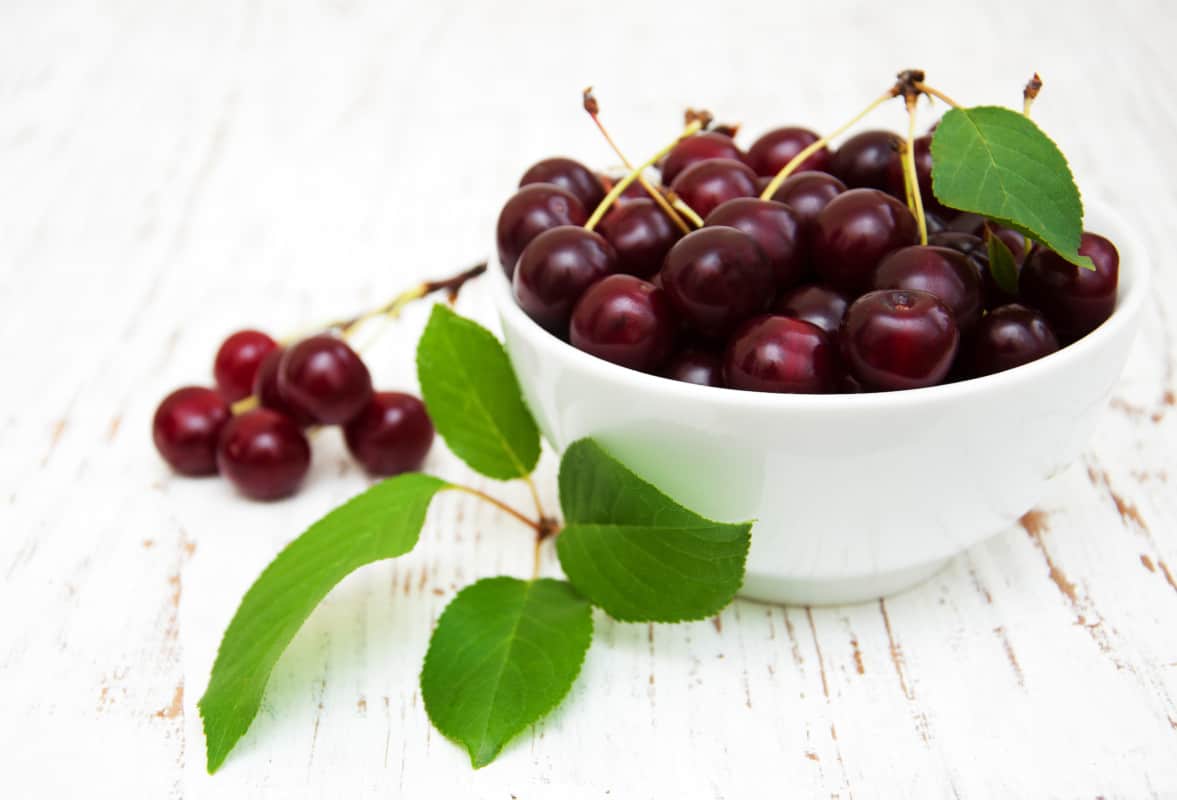
Labradors can eat the flesh of cherries. However, they should not eat cherry pits, stems, and leaves as they contain cyanide which is toxic. When eaten in large amounts, cyanide poisoning prevents your Lab from getting enough oxygen, and shock and death can occur in critical cases.
Symptoms are dilated pupils, bright red gums, and breathing difficulties. Call your vet immediately, as they may advise you to induce vomiting.
Although the flesh of the cherry is safe and nutritious, it can cause your dog to have an upset stomach, so they aren’t recommended. Additionally, the pit is a choking hazard and, if swallowed, can cause a blockage.
Chocolate and Cocoa
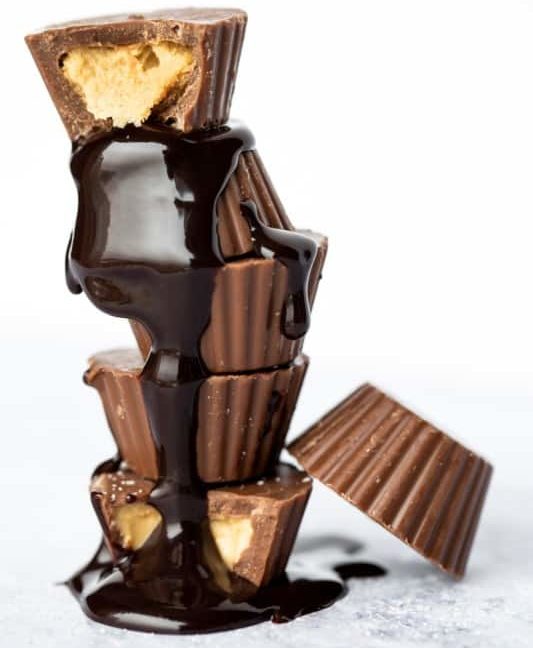
Labradors can not eat chocolate as it is poisonous. It contains the toxic components of theobromine and caffeine that dogs can’t metabolize. Chocolate poisoning can cause vomiting, diarrhea, dehydration, heart problems, tremors, seizures, and death, depending on the amount consumed and its potency.
The most toxic types are dark and unsweetened baking chocolate – the darker it gets, the more poisonous due to the concentrated cacao solids.
Although some Labrador owners think it’s okay to feed their dogs a small piece of chocolate, it really is dangerous.
Additionally, beware of other chocolate products that contain different toxins, such as macadamia nuts, raisins, or xylitol.
Garlic
Labradors can not eat garlic as it is poisonous to dogs. Eating a large amount of garlic will rupture their red blood cells, which leads to anemia. Symptoms of garlic poisoning include rapid breathing, lethargy, weakness, jaundice, vomiting, diarrhea, dehydration, stomach pain, and loss of appetite.
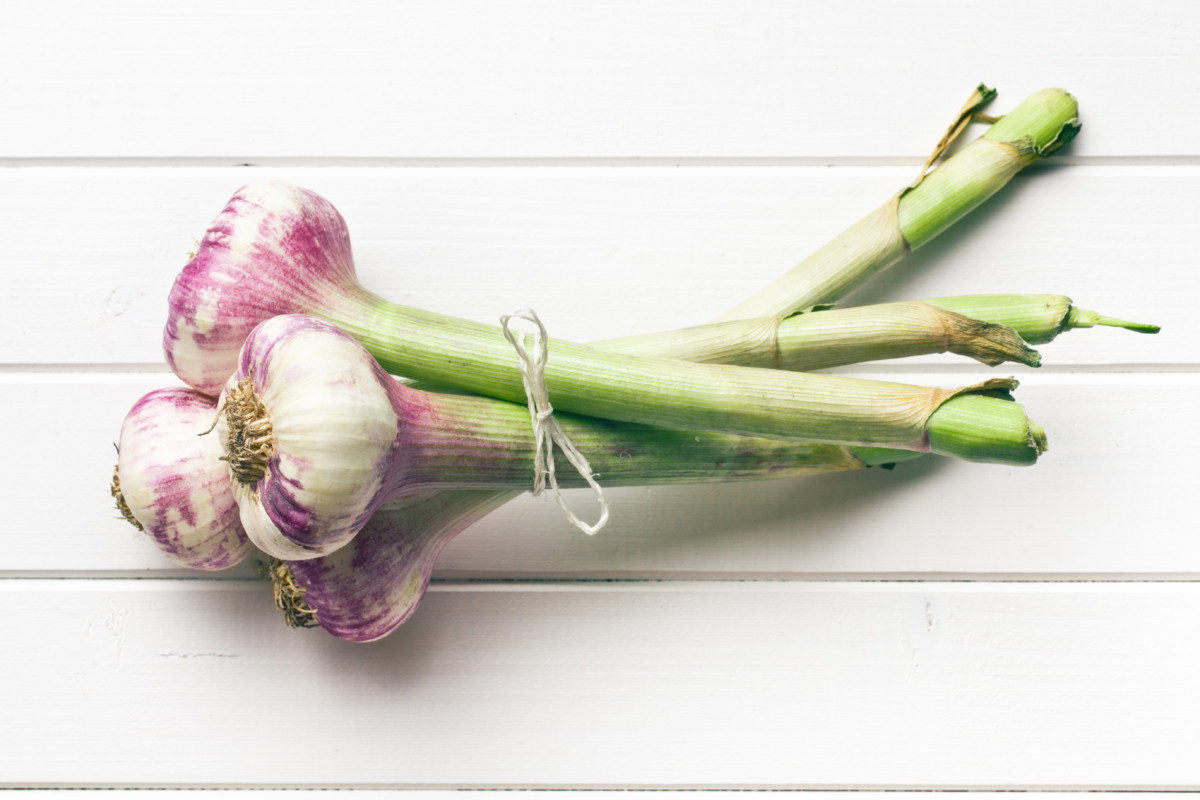
While garlic can be okay for Labradors in tiny amounts, they can’t eat large quantities. However, your doggo would need to eat quite a lot to get very sick, and fatalities are rare.
Also, be aware that signs of garlic poisoning can be delayed and may not be apparent until several days later. Some dogs are also more sensitive than others.
Avoid feeding your dog “people” foods that you have seasoned with garlic, such as garlic bread and bolognese sauce.
Grapes and Raisins
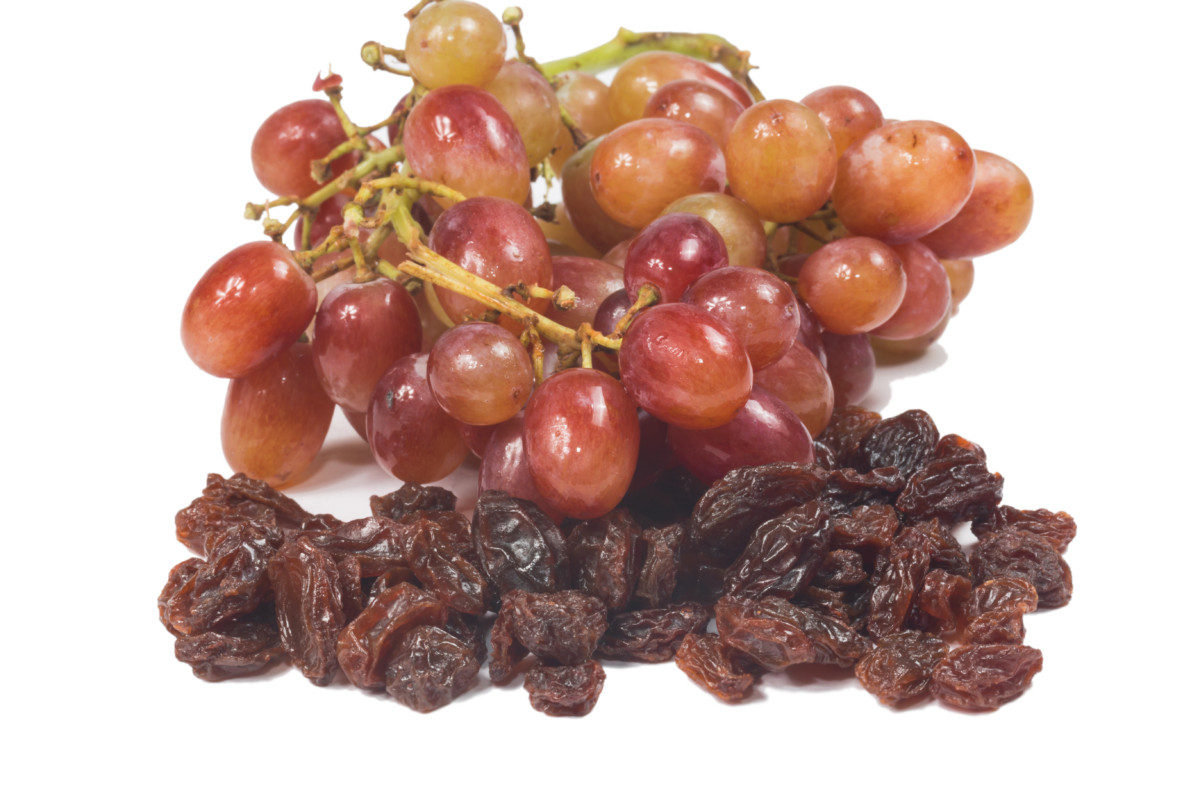
Labradors can not eat grapes. This also includes other dried variants like raisins, sultanas, and currants. Even a tiny amount of grapes or raisins can cause rapid kidney failure in dogs. On rare occasions, death can occur, depending on the quantity consumed.
Scientists have not discovered the source of the toxicity and the exact dosage is unknown. However, some dogs have died from just a handful of raisins, whereas others have survived after eating a much larger amount.
Vomiting within 24 hours of ingestion is typical. Look out for excessive thirst and very little pee. Diarrhea, lethargy, and abdominal pain may also occur.
Beware of any foods containing grape extracts, such as grape juice, breakfast cereals, trail mix, raisin cereal, raisin bread, and baked foods like raisin cookies or scones. These are all potential sources of poison to your Labrador.
Hops (Home Beer Brewing)
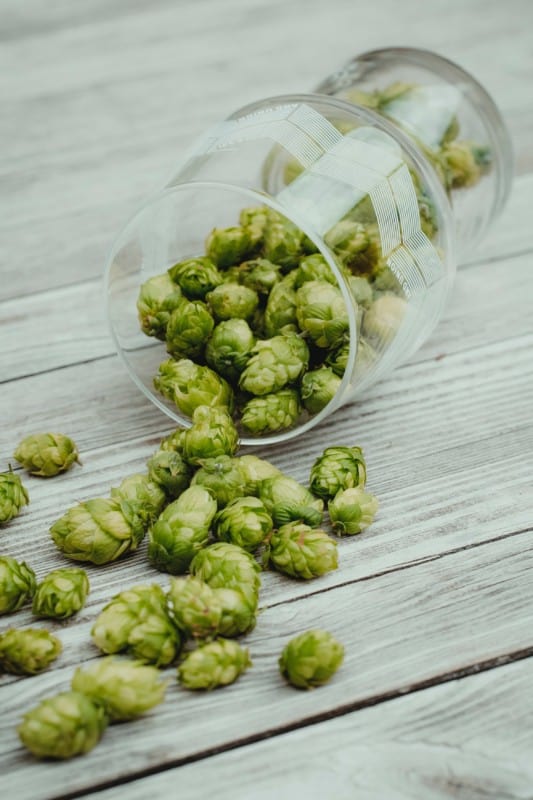
Hops are toxic to Labradors. The toxic element of the plant is still unknown. If you suspect your dog has eaten hops, symptoms to look out for are malignant hyperthermia (which can be life-threatening), a fast heartbeat, panting, vomiting, and stomach pain. In severe cases, death can occur.
Hops are the cone-shaped flowers of the hop plant and are used in the process of brewing beer. They are used as a flavoring in beer and as a stabilizer.
If you are a home-brew hobbyist, you must keep hops out of the reach of your Labrador, whether you use dried flowers or pellets.
Breeds predisposed to malignant hyperthermia, such as the Labrador Retriever may be more prone to toxicity.
Horse Chestnuts (Conkers)
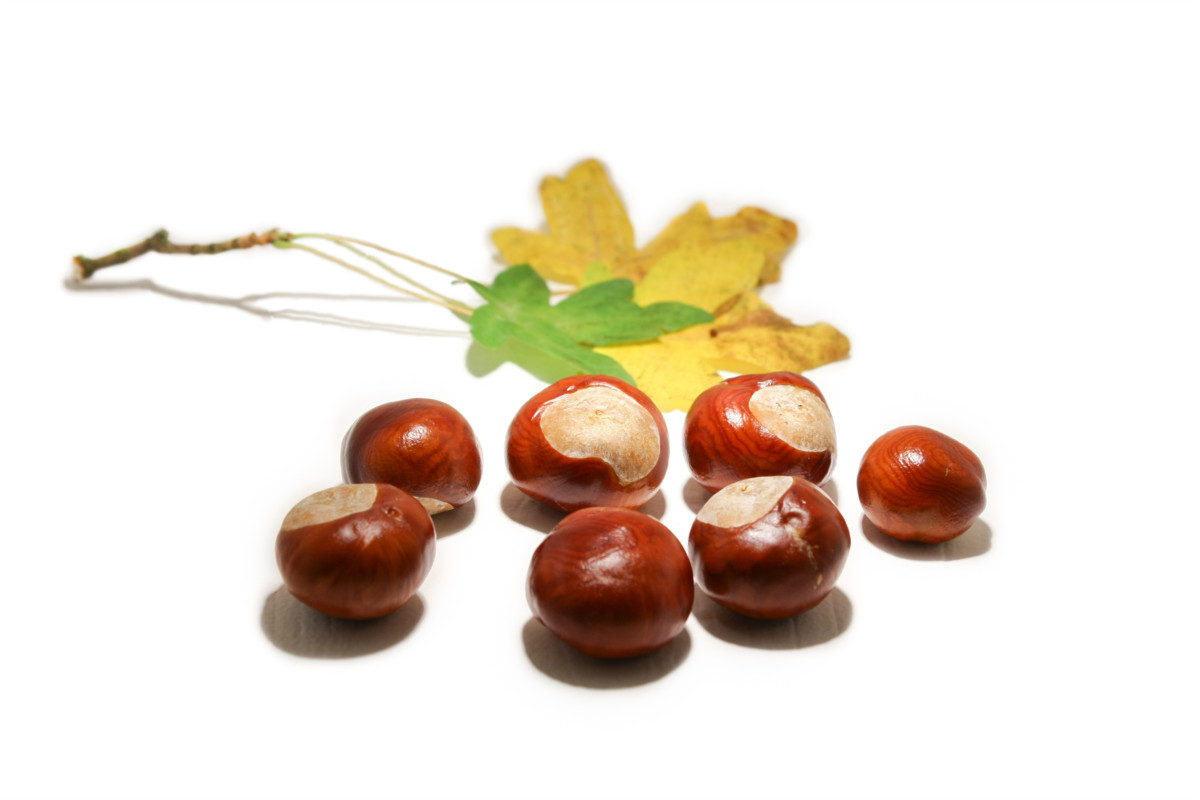
Labradors cannot eat horse chestnuts (also known as conkers) as they contain a poison called aesculin, which is found in all parts of the tree, including the leaves.
The horse chestnut tree is widely found in the UK and temperate regions of Europe, North America, and Asia. Ripened conkers fall to the ground in late summer and autumn, and they are not to be confused with the unrelated edible sweet American chestnut.
Although conkers are toxic to Labradors, they would have to eat several to suffer from any severe poisoning. In low doses, they cause a severe stomach upset, and in higher doses, they can affect the dog’s central nervous system.
Nevertheless, if you think your Labrador may have eaten some conkers, symptoms to be aware of are severe vomiting and diarrhea, drooling, increased thirst, restlessness, and convulsions. Symptoms can occur as soon as one hour after ingesting or may even be delayed for up to two days.
Macadamia Nuts
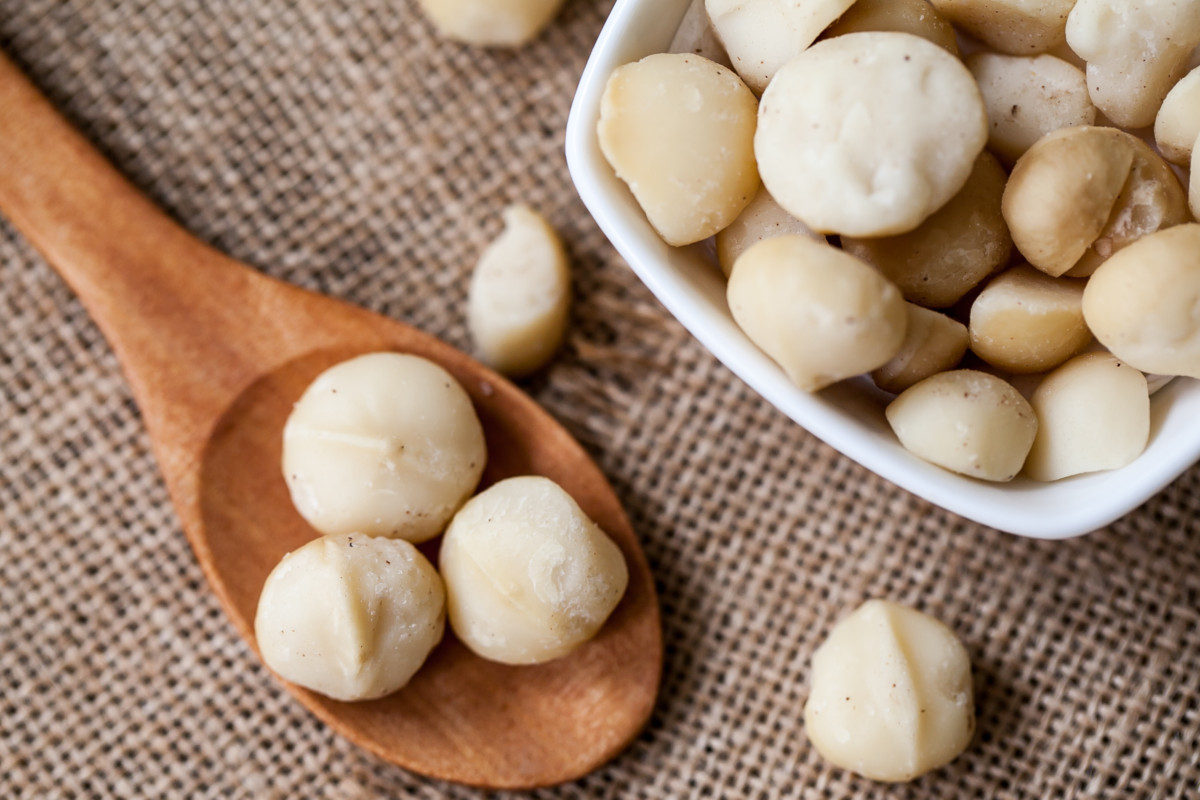
Macadamia nuts are poisonous for Labradors and, therefore, unsafe to eat. The cause of the toxicity remains unknown, but just a handful of raw or roasted macadamia nuts can make your dog quite sick. Vomiting, diarrhea, weakness, hyperthermia, and tremors are common symptoms.
Signs and symptoms usually appear within 12 hours of ingestion.
Although there haven’t been any reported deaths from macadamia nut poisoning in dogs, severe cases have resulted in veterinary care. If you suspect your Lab has eaten some, you must take him to the vet as a precaution.
Beware of other foods containing macadamia nuts, such as baked goods, cookies, trail mix, and muffins.
Moldy Food
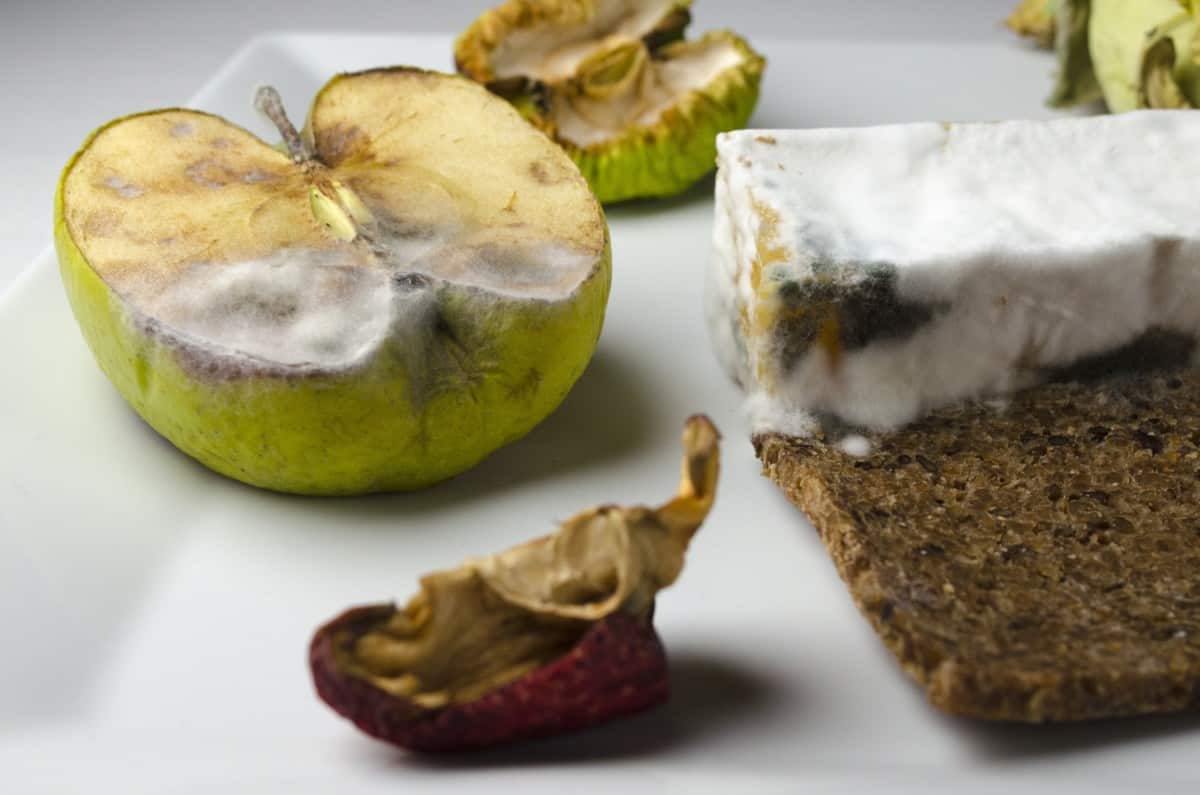
Moldy foodstuffs such as bread, cheese, fruit, and other decaying produce are toxic for your Labrador Retriever. Food mold is a fungus that grows on aged food and, if eaten, can make your dog very ill.
The poisonous substances are known as mycotoxins. Symptoms are vomiting, diarrhea, restlessness, incoordination, tremors, high temperature, seizures, and death in acute cases.
The main dangers to be aware of are if your Lab eats garbage outside, such as moldy fruit or nuts, gets into a compost heap, or manages to get into the household trash.
Mushrooms (Wild)
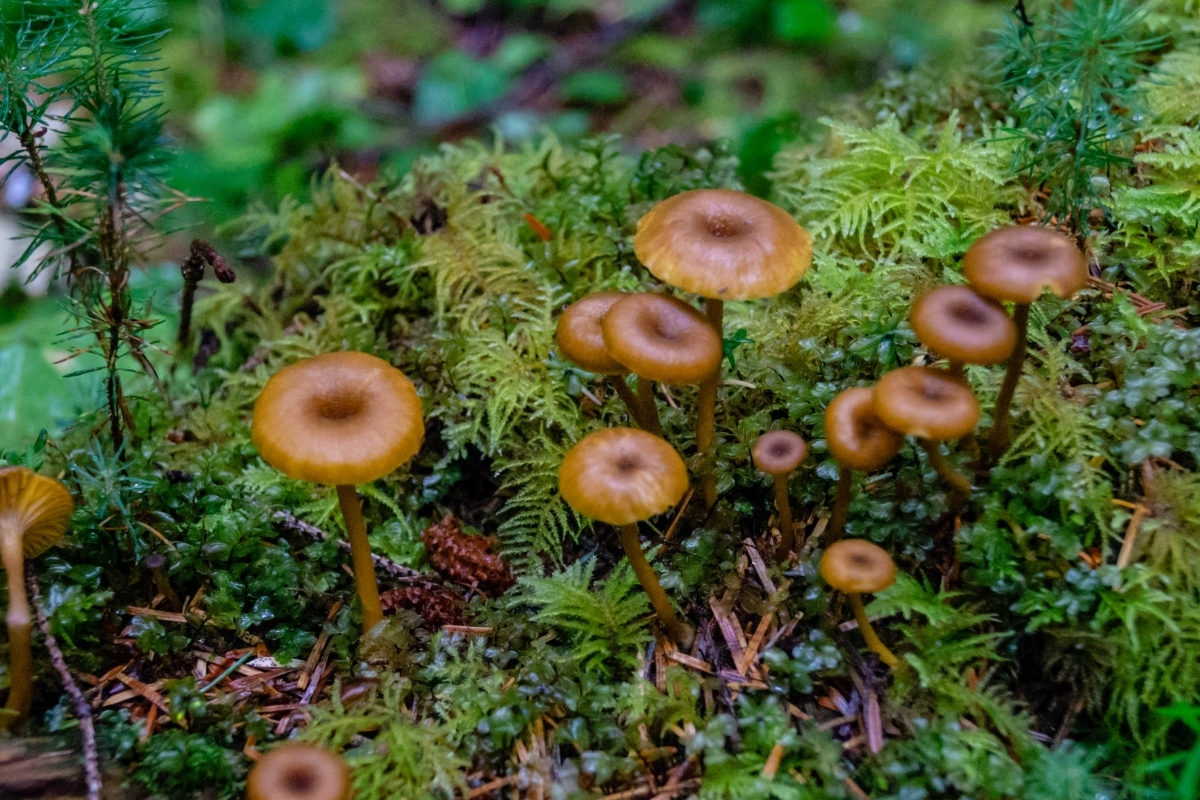
Labradors should not eat wild mushrooms as they can be toxic. Symptoms of mushroom poisoning in dogs depend on the species eaten. Look out for vomiting, diarrhea, tremors, seizures, lethargy, and weakness. Coma, liver failure, and eventual death can occur.
There are thousands of wild mushroom species, and while only a small number are known to be poisonous, should your dog eat a toxic one, it could make him extremely ill. Severe cases of mushroom poisoning can prove fatal.
Some mushroom toxins will affect your Lab within 15-30 minutes, while others will not produce signs for up to 24 hours. If possible, take a mushroom sample to the vets, who can help decide the best treatment depending on the poison.
A small amount of washed white mushrooms from the store are generally safe, such as the white button or Portobello varieties. However, I’m not a fan of mushrooms so I don’t feed them to my dog.
Nutmeg

Although nutmeg is a popular spice used to flavor various sweet and savory dishes, it should not be ingested by your Labrador as it contains a toxin called myristicin.
Mild stomach upset could occur if your Lab were to eat a small amount of nutmeg, and if a very large amount were consumed, myristicin toxicity can cause symptoms such as dry mouth, abdominal pain, disorientation, fast heartbeat, high blood pressure, and seizures.
Although your Labrador would need to consume a considerable amount of nutmeg to suffer serious effects, I thought it would be wise to include it here, just in case your dog happens to find his way into a jar of ground nutmeg!
Nutmeg is also hallucinogenic, so eating a large amount of it could be a scary experience for your dog.
Onions, Shallots, Leeks, and Chives
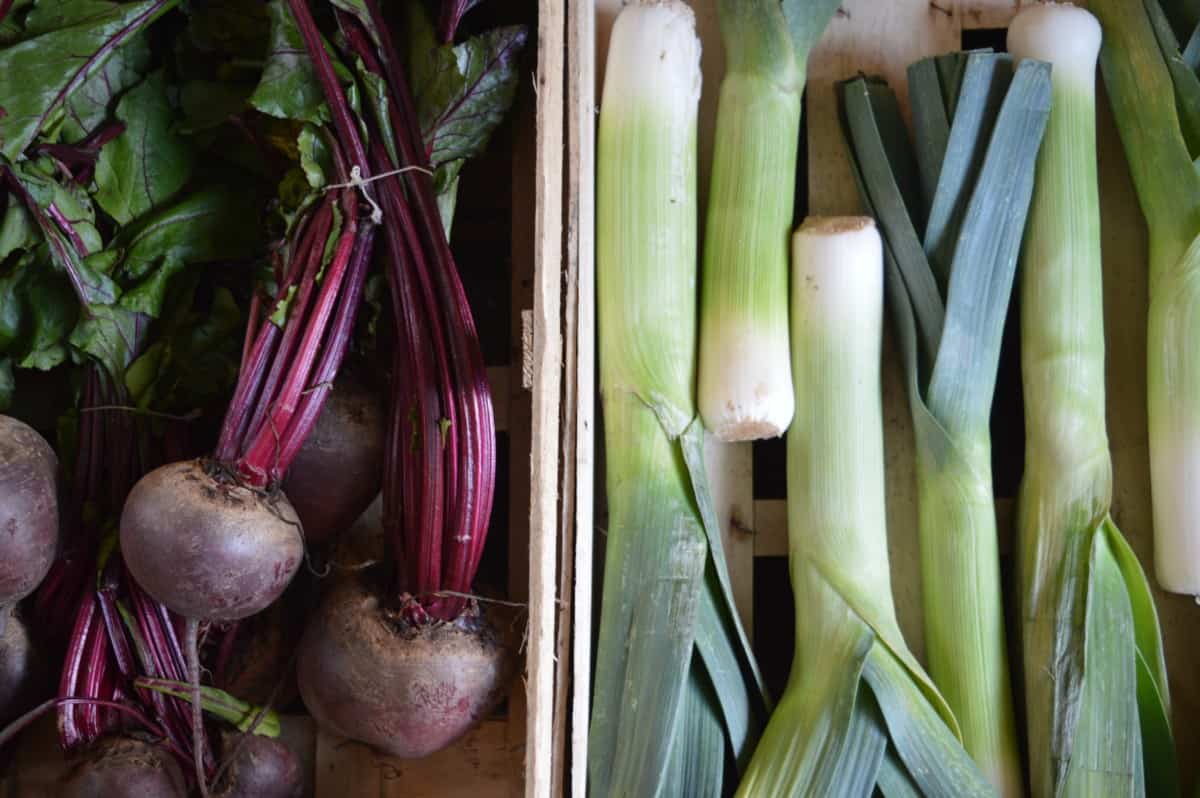
Labradors should never eat onions, shallots, leeks, and chives as they are poisonous if consumed in large amounts. Eating onions (and other Allium foods) can cause your Lab to suffer from anemia due to ruptured red blood cells. In serious cases, an increased heart rate, and often death can occur.
Veterinarians may need to perform a blood transfusion to try to save your dog. Milder symptoms to look out for include nausea, vomiting, diarrhea, and gastroenteritis.
These foods belong to the Allium family (like garlic) and are popular kitchen staples used to season many dishes. They inflame the GI tract (starting with the mouth) causing excessive drooling. Symptoms of the poisoning may have a delayed onset which you need to be aware of.
Don’t be tempted to give your dog leftover bolognese as this is usually loaded with onions and garlic!
Potato (Raw or Green)
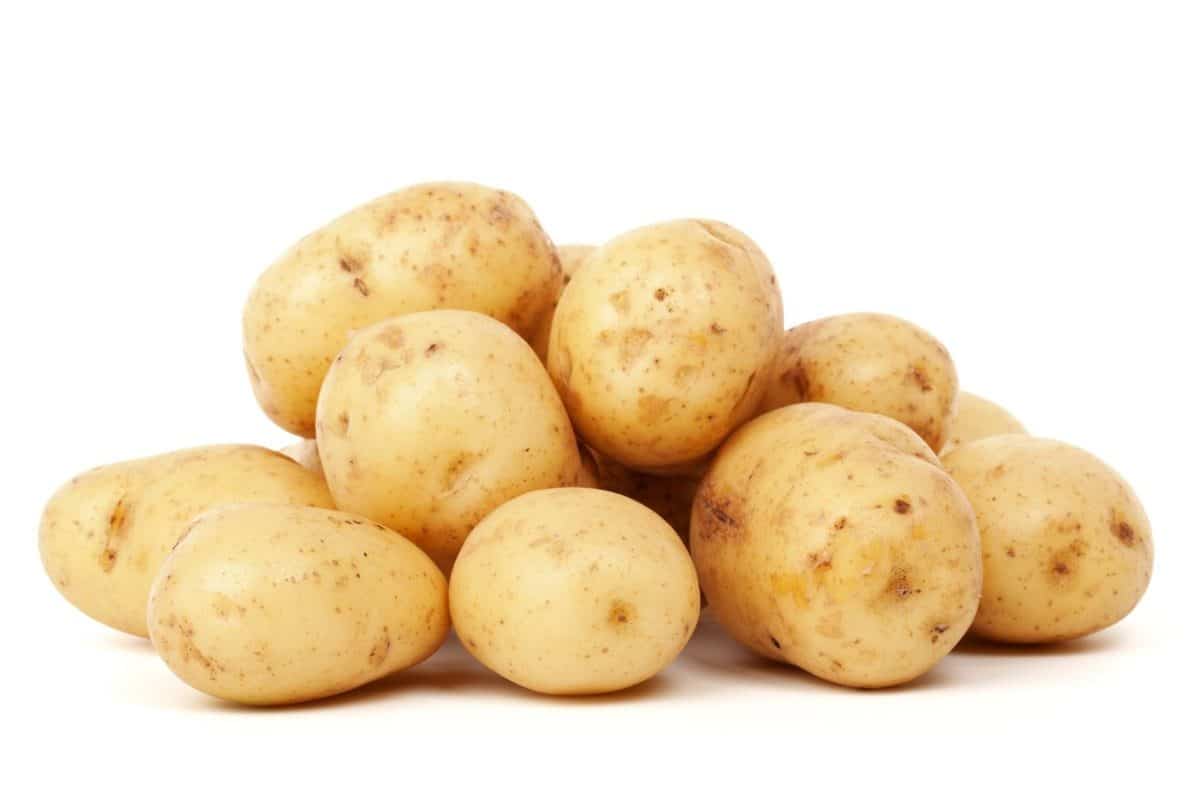
White potatoes belong to the nightshade family of vegetables which contain a compound called solanine that is poisonous to some dogs. (Green tomatoes are also in this group). Solanine is produced as a natural defense to deter insects.
Raw or green potato is toxic to your Labrador, although a large quantity would need to be eaten to cause serious problems. If your Lab consumes a large amount of solanine, his nervous system may become affected and will not function correctly. Symptoms of potato poisoning are vomiting, diarrhea, weakness, confusion, and a slow heart rate.
It is okay to feed your Labrador a small amount of cooked potato as cooking drastically reduces the levels of solanine. Make sure the potatoes are baked, mashed, or boiled, and don’t add butter or salt. If you have a vegetable garden, remember to keep your dog away.
Rhubarb Leaves
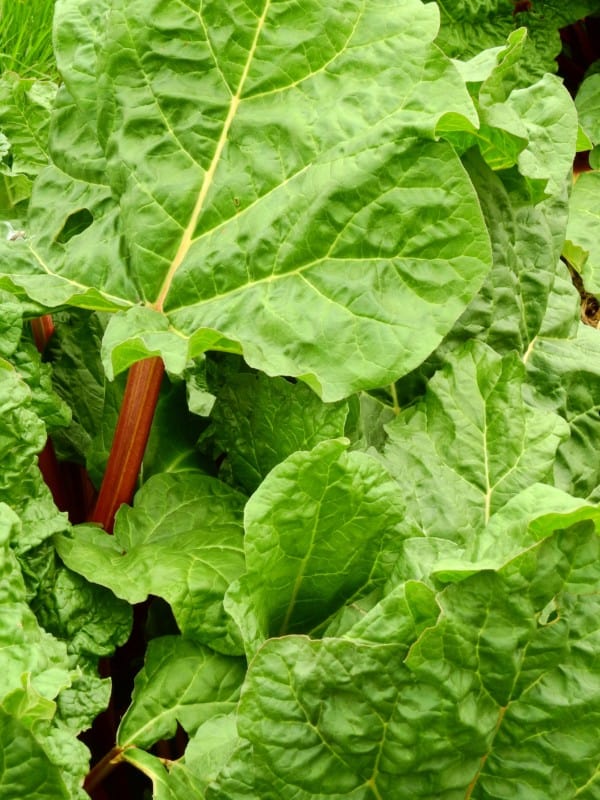
Rhubarb leaves are poisonous to Labradors as they contain soluble oxalate crystals, however, an extremely large quantity would have to be consumed to cause the poisoning. But the stalk of the rhubarb plant is safe for your Labrador in small quantities and can be good if he has constipation.
When the soluble oxalate salts from the rhubarb leaves are absorbed from the gastrointestinal tract, they bind with the body’s calcium, causing a sudden drop in calcium. Symptoms of this type of poisoning in dogs include changes in thirst, drooling, vomiting, diarrhea, weakness, tremors, and bloody urine. Renal failure can occur in extreme cases.
You must be careful if you grow rhubarb at home and ensure your Labrador is always supervised.
Salt
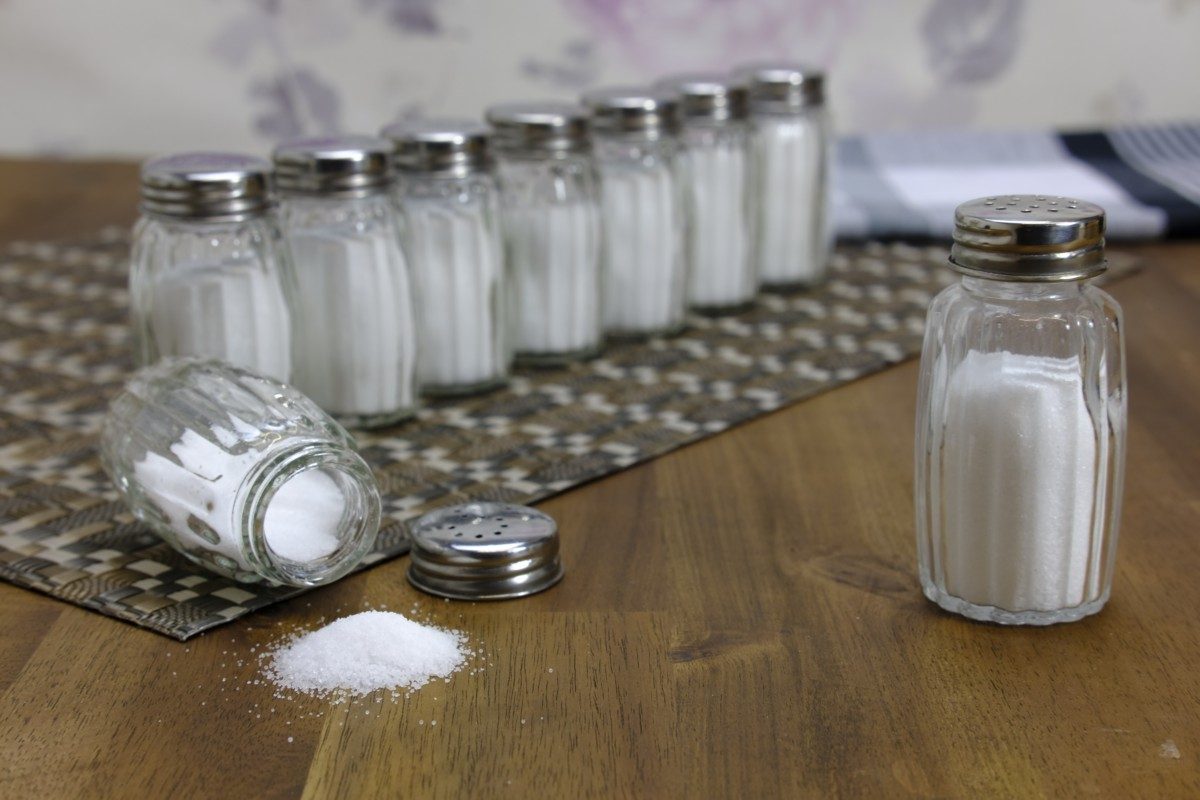
Don’t share salty table scraps with your Labrador as eating too much salt can not only make your dog seriously thirsty or dehydrated, but it can also lead to sodium poisoning.
Too much salt intake in dogs results in vomiting within several hours of ingestion. Symptoms can progress to weakness, diarrhea, muscle tremors, and seizures.
Excessive thirst or urination may occur and potential damage can be caused to the kidneys. Salt poisoning is a concern as it can cause death in serious cases if not caught in time. Just 4 grams of salt is toxic to dogs and this is roughly 3/4 of a teaspoon.
Don’t be tempted to feed your Labrador snacks such as salty popcorn, chips, or pretzels, but instead opt for healthy dog treats. As salt poisoning is often directly related to dehydration make sure your dog has access to fresh water at all times.
You should change your dog’s water bowl every few hours, or you can get a dog water fountain such as the Petsafe Drinkwell from Amazon. I like this one as it’s multi-tiered and even comes with carbon filters to remove odor and nasty taste.
Tomato (Green)
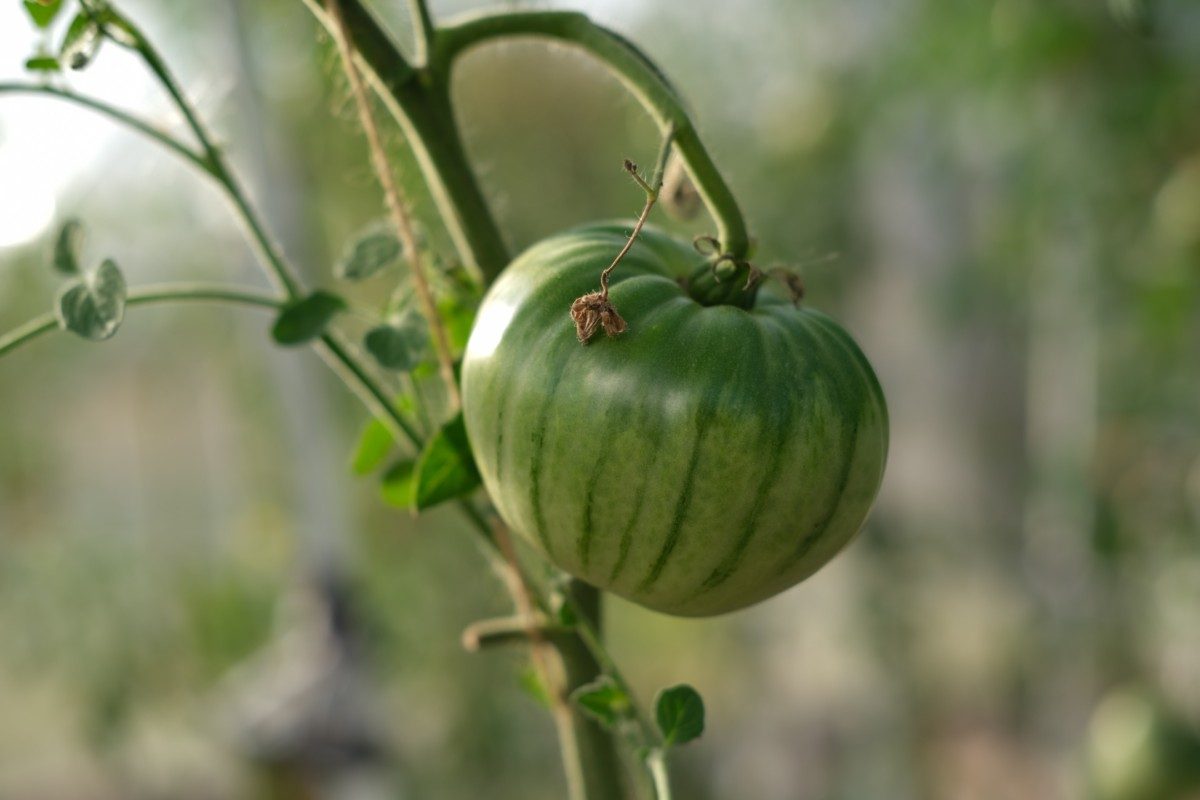
Green tomatoes should be avoided as they are a dangerous food to Labradors if consumed in large quantities.
While the ripened red fruit of the tomato is generally considered safe for dogs, the green parts of the plant (stems and vines), as well as unripened tomatoes should not be eaten.
Green tomatoes contain a toxic substance called solanine (also found in raw or green potatoes) which can cause severe stomach upset, muscle weakness, tremors, heart problems, difficulty breathing, and possibly seizures.
If you weren’t aware of this one, like me, make sure you keep your Lab out of your greenhouse from now on! If you grow tomato plants in your garden, be sure to fence it off preventing your dog access.
Xylitol (Sweet Candies, Toothpaste)
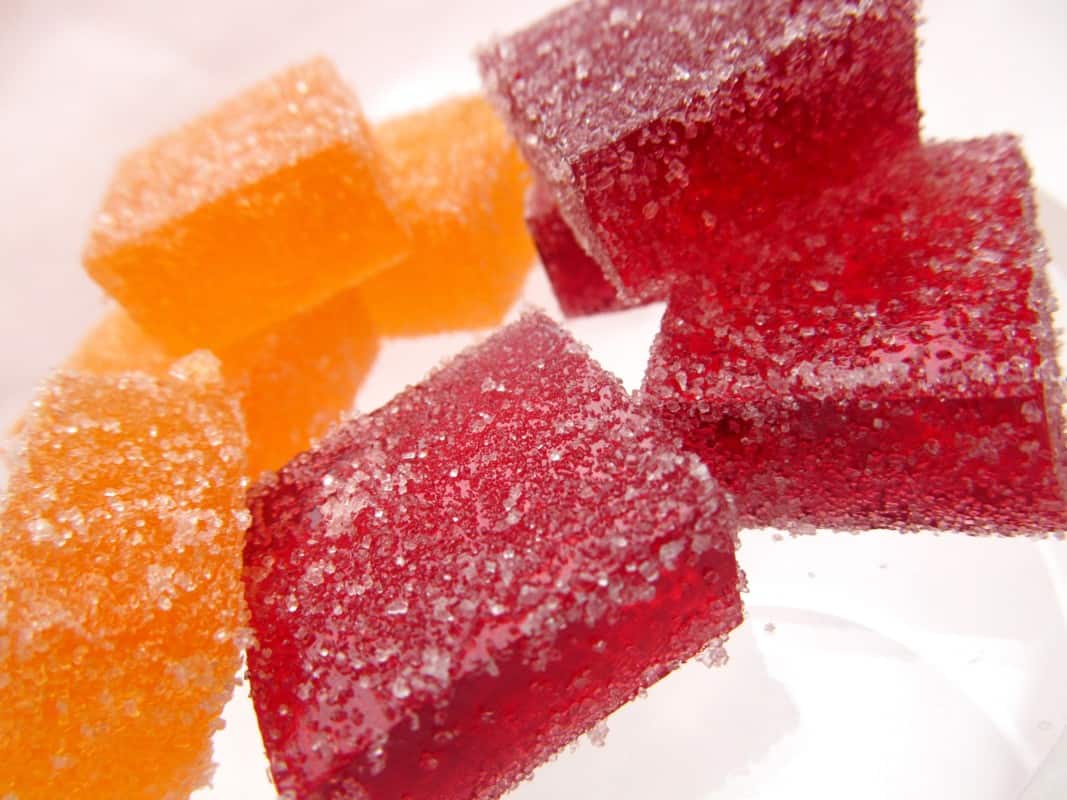
You’d have to be pretty crazy to want to feed your dog candies but a noticeable trend in poisonings has emerged over the past few years due to the increasing popularity of xylitol in several products that many people are unaware of.
Xylitol is a sugar alcohol mainly used as an artificial sweetener that is not safe for your Labrador.
It is found hidden in sweet candies, mints, chewing gum, bread, jams, cookies, other baked goods, and diet foods. It’s even found in toothpaste; another “hidden danger” you might not have known about!
Don’t let your Lab lick your fingers after you’ve cleaned your teeth and always use special dog toothpaste.
If enough xylitol is consumed it can cause life-threatening low blood sugar and leads to acute liver failure. Symptoms can occur within 30 minutes of ingestion and include vomiting, lethargy, coordination problems, seizures, and even coma.
Although Labradors can eat peanut butter, be aware that some brands contain xylitol and always check the label first or buy an organic brand.
Yeast Dough
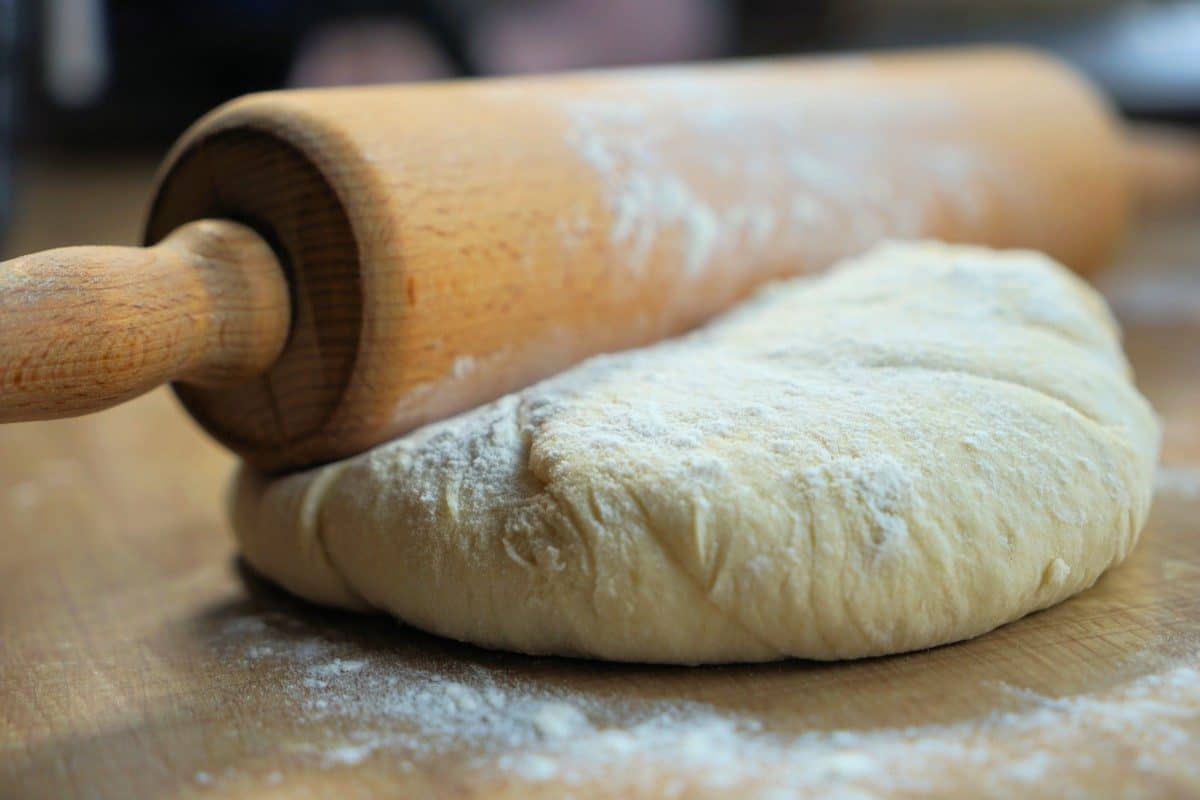
When yeast dough ferments, it produces alcohol that can lead to alcohol poisoning and ultimately the death of your Labrador.
In addition to this, raw bread dough needs to rise and if your Lab eats it, his stomach will act as an oven causing the yeast dough to rise. The dough then swells inside, and as it expands, it causes a bowel obstruction or a bloated stomach which causes immense pain, especially if the stomach twists.
This then becomes a life-threatening emergency requiring abdominal surgery. Obvious signs are a distended abdomen and your lab may also suffer from difficulty breathing, retching, weakness, collapse, and shock.
What to Do if Your Labrador Ate Something Toxic
No matter how careful you are, your Labrador Retriever might find and ingest something dangerous. If you suspect your dog may have eaten something toxic, you must take emergency action by contacting your veterinarian for advice.
Two other helpful resources are also available 24 hours a day. These are the Animal Poison Control Center(ASPCA) and Pet Poison Helpline.
A consultation fee may apply, but the sooner your Labrador’s poisoning is diagnosed and treated, the better chance of recovery he will have.
“The prognosis is always better when a toxicity is reported immediately. It’s always less expensive, and safer for your pet for you to call immediately.”
Pet Poison Helpline
These are the emergency instructions to follow if your Labrador ate something toxic, courtesy of Pet Poison Helpline:
- Remove your dog from the area, and make sure no other pets are exposed. Safely remove any remaining toxic food from their reach.
- Check to make sure your dog is breathing normally and acting okay otherwise.
- Collect a sample of the foodstuff and packaging as you may need the information when you talk to your veterinarian or a Pet Poison Helpline expert.
- Don’t give your dog any food or milk or any other home remedies! Also, never induce vomiting or give hydrogen peroxide to your dog without talking to your vet or Pet Poison Helpline first.
- Get help. Make sure you have your vet’s phone number, along with an emergency vet and the Pet Poison Helpline phone number (855-764-7661) in your cell phone.
A Vet’s Perspective
I was lucky enough to interview licensed veterinarian TB Thompson, DVM from Natural Pets HQ, on food toxins. It’s great to get a vet’s perspective on such an important topic, and she gives some great tips to keep your dog safe:
Q. From your experience, what is the most common food involved in accidental ingestion in dogs that causes poisoning that you see in your practice?
A. “The most common toxic food ingestions I see are chocolate and grapes/raisins. It’s often the case that a dog has eaten something containing those ingredients, like cookies or muffins.”
Q. Xylitol appears to be in so many products these days. Have you witnessed any cases of xylitol poisoning?
A. “I’ve seen a few cases of xylitol toxicity. One I remember was a dog presented to the emergency clinic after having eaten some sort of diet food with xylitol in it. He was brought in because he had a seizure at home. We found his blood sugar was very low. He ended up recovering well after being treated for a few days in the hospital.”
Q. Many people will try to make their dog sick if they’ve eaten something they shouldn’t, but what should they really do?
A. “Sometimes inducing vomiting can make things worse. The best thing to do if you think your dog has ingested something toxic is to call an animal poison control center immediately. In the US, we have two great resources in the ASPCA Poison Control Center and Pet Poison Helpline. These people are amazing! Tell the veterinarian at the poison control center what your dog ingested and how much he got. They will give you specific instructions on what to do next.”
Q. What have you found to be the most prevalent reason for dogs ingesting toxic foodstuffs? Is it down to a lack of knowledge by the owner, or the dog getting into places he shouldn’t, such as handbags, cupboards, or the garbage?
A. “Most of the time, dogs get into food that has been left out on a table or other accessible area. Occasionally we have to do some sleuthing to figure out what made a dog sick when their owners aren’t aware that a particular food is toxic to dogs.”
Q. What is your best tip to poison-proof a home?
A. “Keep all food in a high cabinet or another place your dog cannot access. Use child-proof cabinet locks if your dog is very crafty. Always look around before you leave home to make sure you haven’t left anything on the counter or table that your dog might like to eat.
Keep your garbage containers in a locked cabinet or pantry. Don’t ever assume your well-behaved dog won’t try to get at food, personal hygiene products, or medications when you’re not around! Another option is to crate your dog when you’re not home.”
What Human Foods Can Labradors Eat?
Although I make sure my dog has a healthy, well-balanced diet, I like to give her some human food either as treats or as a topping in her food bowl to change things up for her. So, what human foods can Labradors eat?
Labradors can eat various human foods as long as they are given sparingly and they don’t have any allergies or sensitivities. These include proteins such as lean meats and fish, some fruits and vegetables, dairy foods, and plain cooked rice and pasta.
The general rule of thumb is that treats should not make up more than 10% of your Labrador’s daily calories. Ensure the foods you give your dog are safe, cooked, lean, and plain, with no salt or seasoning.
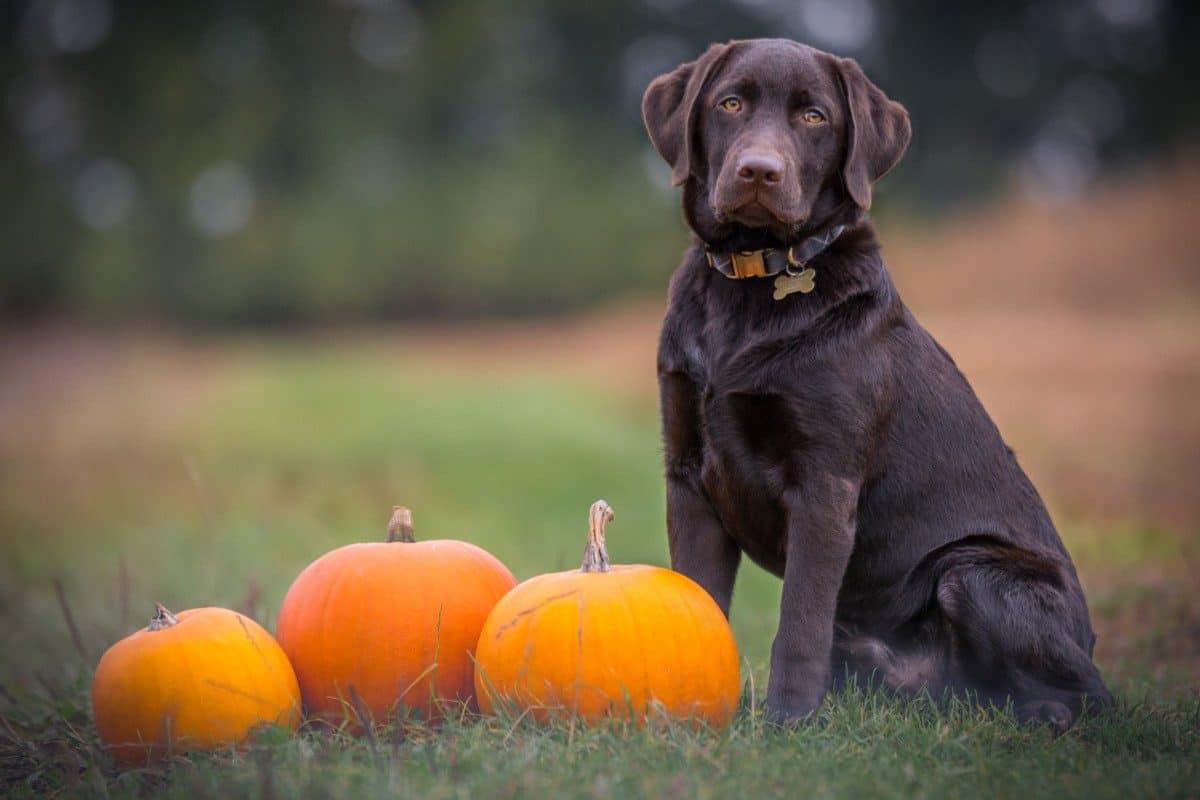
Below is a brief synopsis of the foodstuffs that are safe for your dog to eat. However, I have a more comprehensive article on the best diet for Labradors, including nutrition, types, and exactly what they can and can’t eat.
Lean Meats
Labradors can eat lean cuts of cooked meat as long as all the visible fat is removed. My dog enjoys chicken, turkey, pork, beef, and lamb. Avoid processed meats like bacon, sausage, and ham due to their high levels of salt or seasoning.
Make sure that there are no bones in the meat before you feed it to your dog as cooked bones are dangerous. They can easily splinter into shards that can cause choking and serious damage to your dog’s GI tract. If you like to give your Lab a bone make sure it is raw and larger than his muzzle, such as a large beef shank bone.
Fresh Fruits and Vegetables
Slices of apples or bananas make tasty treats for your dog. Berries such as strawberries and raspberries are also fine and you can even freeze them in summer to help keep them cool.
You can also feed your Lab apricot, nectarines, peaches, and plums but you must take out any seeds or pits as these contain cyanide and can cause poisoning if eaten in large amounts.
It’s also okay to let your Labrador eat vegetables such as carrots, green beans, peas, sweet potatoes, or pumpkin. Most vegetables should be cooked as your dog will find them easier to digest, although raw carrots and green beans are fine.
Vegetables are a healthier option than fruits due to their lower sugar content. To discover exactly what vegetables Labradors can eat, check out this article.
But if fruits are more your thing, check out this article, 29 Fruits Labradors Can Eat: And 5 They Can’t!
Cooked Rice and Pasta
Dogs can eat cooked plain rice and cooked pasta. Cooked, plain white rice can be a good option if your Lab has an upset stomach as it is easy to digest and quick to prepare. Rice is often found in dog food and my dog’s food contains 29% brown whole-grain rice which is a healthier variety.
Pasta must not contain any sauces as they often contain garlic and onions which they can’t eat and dogs with a wheat allergy or a sensitivity to grains or eggs shouldn’t eat pasta.
Dairy Products
Dairy products, such as cheese, milk, or plain yogurt, are generally safe for Labradors as long as they are fed in very small quantities. Eating too much dairy can cause diarrhea or vomiting in some dogs if they are lactose intolerant as they cannot break down the sugars in these foods.
Fish
Fish is a healthy source of protein and is rich in omega-3 fatty acids which are good for your dog’s immune system, coat, and skin.
Dogs can eat fish as long as it’s fully cooked and without any added oils or seasonings. Make sure it doesn’t contain any bones. You shouldn’t feed raw fish due to the risk of bacteria such as salmonella.
As a special treat for my dog, I like to give her fresh salmon which she adores. There have been some concerns about longer-living species of fish such as tuna and mackerel containing higher levels of mercury, so if you choose these types, only occasionally feed a small amount.
Final Thoughts
When your Lab stares at you with those longingly sad eyes hoping for a quick bite of your food don’t be tempted to give him some unless you are 100% sure it is safe.
Should your dog accidentally eat something toxic, don’t worry though, as he would have to eat a large quantity of most of the poisonous foods in this article. However, it’s important to be aware of them all as one or two can have fatal consequences after consuming just a very small amount, such as grapes.
If you do suspect your dog has eaten something he shouldn’t, follow the above advice on what to do and take immediate action. The prognosis is always better when toxicity is reported straight away, so don’t wait to see if your Lab becomes unwell before seeking help.
Finally, it’s wise to get advice from your vet if you’re in any doubt about whether a particular food is okay for your dog to eat, especially if he has any medical conditions, allergies, sensitivities, or is overweight. I take no responsibility should you decide to give your dog a raisin muffin, some candies, or a gulp of beer!





